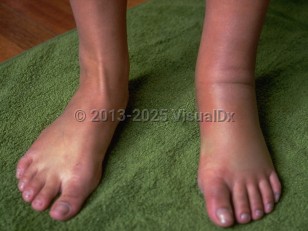Loiasis
Synopsis

In long-term residents of endemic areas, infection can be asymptomatic despite large numbers of microfilariae in the blood.
Because travelers to endemic regions are not immune to L loa, infection is characterized by localized subcutaneous swellings (Calabar swellings) and angioedema, both representing localized allergic reactions to L loa. These swellings are transient, lasting several hours to days, and most commonly occur on the extremities and face. Occasionally, migration of adult worms can be seen within or outside of the Calabar swellings as a moving wormlike structure. Pruritus or pricking sensations from adult worm migration is common in addition to arthralgia, fatigue, and myalgias. If the adult worm migrates under the conjunctiva (seen in 10%-20% of patients), a Calabar swelling can occur periorbitally, and this can be associated with eye pain.
Complications can include meningitis, encephalitis, nephropathy, endomyocardial fibrosis, and rarely, pulmonary involvement. Although loiasis is generally thought to be benign, these complications and an increased risk of mortality are more often seen in patients with high microfilariae levels and those living in endemic areas.
Codes
B74.3 – Loiasis
SNOMEDCT:
44250009 – Infection caused by Loa loa
Look For
Subscription Required
Diagnostic Pearls
Subscription Required
Differential Diagnosis & Pitfalls

Subscription Required
Best Tests
Subscription Required
Management Pearls
Subscription Required
Therapy
Subscription Required
References
Subscription Required
Last Updated:03/23/2022

